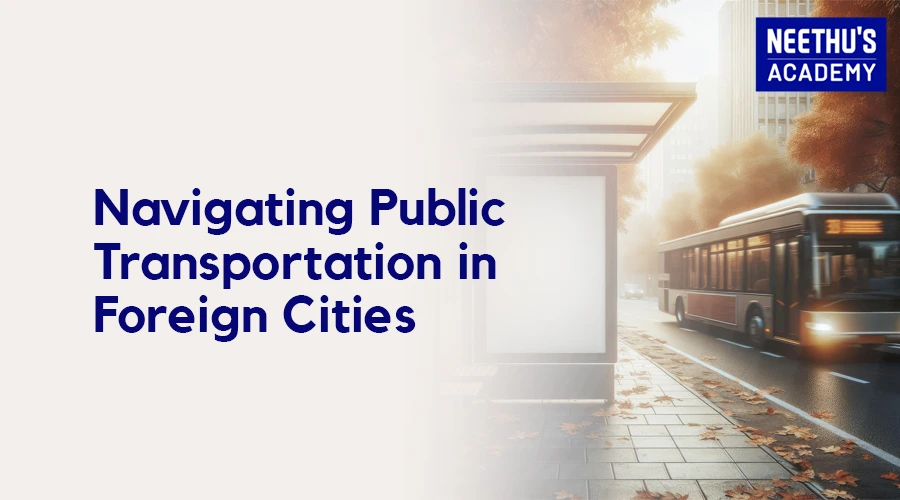Public Transportation Abroad: All You Need to Know Before You Go
Traveling to a foreign country is enjoyable, and perhaps the most difficult part is to navigate the cities across the world. Unfamiliar routes and complicated ticketing systems-these factors might make public transportation quite a challenge for a newcomer. However, once you are able to utilize public transport it becomes easier, more economical, and more eco-friendly for your trip. The following guide is an in-depth one, which talks about everything about public transport, from ease of usage to navigation, and a few essential tips for a hassle-free trip.
Understanding the Basics of Public Transportation
Before boarding a bus, train, or tram in another country, you should understand some basics of how public transportation systems function. Because public transportation services vary from city to city and country to country, they generally provide the following:
Buses: They are the most prominent types of public transport and are available in nearly every major city. In many cases, they travel long distances, not only through cities but also to suburban areas, making them suitable for long commutes within the city.
Trains/Metros: Urban rail services generally in the form of subways or metros, constitute one of the fastest modes to move around any big city. They cover major neighborhoods and usually operate very efficiently, especially during peak hours. Long-distance trains are available, also for crossing over long distances or shifting from one city to another.
Trams/Light Rail: Trams are relatively smooth, convenient ways to travel in city centers. They often stop very frequently and are highly popular in European cities, such as Amsterdam and Prague.
Ferries: Ferries are used in cities with direct access to coastlines, like coastal cities or cities built on rivers (Sydney, Istanbul, or Hong Kong). Ferries are a beautiful way to get around and often provide good views of the skyline.
And each of the modes has a different time schedule and way of ticketing as well as regulation for each of them. Familiarizing yourself with these services before your arrival there can avoid you much stress and make your journey even more enjoyable
Benefits of Using Public Transportation
Cost-Effective: Public transport is far cheaper than taking taxis or car rentals. Many cities offer daily or weekly passes whereby one can travel any number of times by bus, train, and tram at a fraction of the cost of private transport.
Eco-Friendly: Public transport reduces carbon footprints. Trains, buses, and trams can carry lots of people using comparatively lesser amounts of fuel compared to private transport, thus reducing aggregate emissions in cities.
Effective: Public transport is usually faster than driving, especially in the morning or afternoon rush hours when traffic jams are common. Trains and metro systems usually run on their own track and are not influenced by traffic jams.
Participation in culture: One of the best ways to learn a foreign city is through one of its public transport systems. The use of the local buses or trams gives one the opportunity to take in everyday life as well as interact with the residents more authentically than in areas that are laden with tourists.
No parking hassles: Renting a car in a foreign country comes with all the usual stuff, including looking for parking, trying to find out the usually subtle traffic rules of the place, and subsequent fines. Public transport avoids all that, ensuring that you spend your trip enjoying itself rather than getting frustrated.
Leisurely Exploration: Using public transport allows you to sit back and take in the journey. Whether watching the streets go by on a bus or ferry ride, public transport often works to transform travel time to be part of the excitement of your exploration.
Pre-Travel Preparation
Availability of Public Transportation: All cities do not have well-developed public transport systems. So, check if the destination you are traveling to has buses, trains, or other services. In small towns or village areas, you won’t find public transport.
Timings: A few cities have the service running through day and night while others are limited to specific hours. Buses and trains do not run in some cities after midnight, and sometimes there are fewer services during weekends and holidays. This means that you will avoid being stranded due to knowledge of the schedule.
Cost/Fare: The public transport fares vary from country to country and within a city, station-wise and zone-wise. Many offer day and weekly passes; if you are planning to travel by public transport very frequently, then it will save you money. Also, check if the city offers any tourist passes that enable you to travel unlimited for a period.
Where to Buy Tickets: Tickets are available at kiosks, stations or through mobile apps. In some cities, the ticket needs to be purchased prior to boarding, while in some other cities, it can be bought onboard. Research where and how tickets need to be purchased for the system you are going to use.
Use Google Maps or Citymapper
These apps are really useful for someone who wants to wander around a foreign city on public transportation. Both Google Maps and Citymapper provide actual, real-time directions and updates on public routes. Citymapper has even more detail on routes in specific cities, detailing the exact way from point A to point B with step-by-step instructions. These applications will tell exactly which bus or train to take, where to make a transfer, and when to get off.
Get Your Head Around Tickets
Ticketing systems in other countries can be quite confusing sometimes. Paper tickets may be the mode of use in some cities, while others use rechargeable cards for travel, such as the Oyster card introduced in London or the Octopus card in Hong Kong. Even now, contactless payment is replaced by mobile apps. For your preparations, just be aware of the system used so you don’t get caught off guard.
Challenges While Traveling Abroad
One has to learn to decipher signs and announcements, which can be painful when not speaking the language. A good translation app is a godsend in such times.
Overcrowded Systems: Public transportation systems are extremely crowded, and sometimes even claustrophobic, especially during rush hour in cities as crowded as Tokyo or Paris. Be ready for buses or metro cars that are packed in.
Unknown Routes: Metro routes in an unknown city a always disorienting, especially when you are required to change buses several times. Be prepared to spend a little more time so that you don’t miss a stop or get lost.
Payment Systems: Each city has its payment system and finding it for the first time can be quite confusing. Sometimes, for traveling, you need a special card, sometimes cash is sufficient, and sometimes tap payments can be made using an app.
Safety: Public transport is pretty safe, but one must also be careful, particularly late in the night or when taking transport in a new place. Research beforehand the places you are visiting to know about potential dangers beforehand.
To sum up
Navigating foreign city public transportation is intimidating, but for those who research their destination properly and prepare themselves for how to make their way around, it’s one of the easiest, cheapest, and most rewarding experiences of your journey. Riding a bus across town or hopping the ferry means you get to be like a local in that city. As long as one does not forget cost saving, to lessen environmental impact, and to practice culture immersion, the discipline required to become adept in public transportation services abroad is well worth the trouble. Well, the next time you’re heading out for a trip, leave your car behind and try the adventure of using public transport instead.
Frequently Asked Questions





